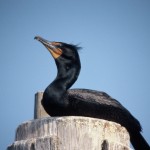Puget Sound species
Creating a checklist of the species of the Puget Sound watershed sounded simple enough. It was one of the first orders of business for the new Encyclopedia of Puget Sound. If you are going to try to create a comprehensive collection of information about a natural system, it makes sense to first find out what occurs in that system.
Creating a checklist of the species of the Puget Sound watershed sounded simple enough. It was one of the first orders of business for the new Encyclopedia of Puget Sound. If you are going to try to create a comprehensive collection of information about a natural system, it makes sense to first find out what occurs in that system.
Trouble is, no one has ever done it. Not that there aren't plenty of lists out there. It's just that like the Hindu deity Shiva, or the deep mysteries of quantum mechanics, the lists seem to vary depending on how you look at them.
First you have to determine agreed upon geographic boundaries. What exactly is the Puget Sound watershed? Or is it better to include the entire Salish Sea, where ecological boundaries trump political? You must also decide which types of species to include. Residents, migrants, plants, animals, vertebrates, invertebrates, fungi, lichens, the taxonomically novel tunicates... Do you divide the lists into terrestrial and non-terrestrial vertebrates, freshwater and marine? What about algae? There are many lists, but one size does not fit all.
Our solution has been to gather different frameworks and points of view. We have collected many excellent lists that we will include in the Encyclopedia (see: www.eopugetsound.org). These include Puget Sound fishes, common macro-invertebrates (in our case mostly shellfish), rare plants, plants of the Puget Trough, indicator species recognized by the Puget Sound Partnership, invasive species, Salish Sea-reliant Birds and Mammals (a relatively new list by Joe Gaydos and Scott Pearson) and so on. We also created our own list.
Thanks to new species range and modeling data from the USGS Northwest Gap Analysis Project, we were able to create a list of terrestrial vertebrate species occurring within the Puget Sound basin. According to that list, a total of 421 species of terrestrial birds, mammals, amphibians and reptiles occur within the geographic boundary. On one hand, it's sort of an arbitrary number, and only an estimate at that (the ranges are based on distribution models). It's a subset of a sub-phylum and nowhere near a 'one size fits all' list. On the other hand, it moves us a little closer to understanding what it is that we are referring to when we talk about protection and restoration of Puget Sound. These are the animals we find in our backyard, so to speak. Check it out, along with all the other lists when a beta version of the Encyclopedia goes 'live' this spring.
Recent blog posts
PSI eNews Archives

This Encyclopedia's parent organization, the Puget Sound Institute, also publishes an email newsletter. Visit the PSI blog to subscribe to the PSI eNews or peruse past issues.






